You need less proton in your diet
I don’t think I should be using my brain today.
Hmm
The process of seeing involves photons hitting the back of your eye. They weren’t invisible before then, just that there was nothing to see them.
It’s an interesting philosophical discussion, but I think you might be on the side of pontificating bollocks at the moment. Not that there’s anything wrong with that.
This. His argument about searchlights, torches etc (sunlight, candles, glow-worms, Hawking radiation …) is a good one. It is true that you can’t see light if it goes past your eye rather than into it. I used to work with very high power lasers and visitors were always disappointed that there weren’t beams like this everywhere
Even with very high power beams indeed there really weren’t. If you want to see such a beam you either have to stick your eye into it (in which case that will be the last thing that eye ever does see) or you have to scatter a fraction of the beam into the eye. Airborne dust works quite well as a scatterer. The blast from a CO2 fire extinguisher or a stage smoke generator works a lot better
Fluorescent dyes can be excellent ways of following beams around (they’re not just scattering the beam though)
VB
So (obviously theoretically) would we see the bolts from phasers/star wars blasters etc In space if they were real? I know there was some high powered laser stuff tested after the Reagan SDI programme.
You’re all talking rubbish. You can see proper stuff all the time - protons, photons, strapons, all them things. I know 'cos I’ve seen them all on telly and telly doesn’t lie when it’s a factual science programme
“The outer limits”
Isn’t that your postcode?
Close, but we are way further away than that 
Beyond the bounds?
Thank you so much for hearty laugh.
That would depend on how much stuff (residual gas, dust etc) was in the particular region of space and on how powerful the light beam was. With the sorts of lasers we can make now we wouldn’t be able to see the beam pass by once it was properly out of the earth’s atmosphere. It’s why working with high power beams can be so very dangerous. Even in clean lab air you don’t know where the beam is until you inadvertently move a screwdriver or a bit of jewellery or almost any kind of optical equipment into it. Then ‘pop’ (that’s your retina exploding) and it’s too late. So we wear goggles. Always.
I did work for a year on the SDI program in the late 80’s. We were making a very powerful laser to shine into the sky and scatter off stuff with a view to working out which bits of the stuff were chaff and which bits were, um, going to hurt us. We never shone it outdoors (the US Navy might or might not have done though). Most of the SDI ‘directed energy’ lasers would probably have had to have been X-ray lasers.
VB
Thank you, for more information.
Alternatively, the ‘lasers’ could actually be firing matter that radiates light. That would fit in with the speed as well.
That would be tracer, or fireworks, both very effective in their own ways.
VB
Alternatively you can use a pair of scissors to cut it into very very small pieces.
That folks is the difference between science and engineering,
I thangyou.
More laugh out loud heartily
Interesting, because a Sci fi blaster effect always seems to me quite slow, perhaps even slower than a bullet. I know it’s all bollocks and artistic licence, but it interests me, because a laser bolt of say a foot long by an inch diameter, travelling at light speed, whether or not it was a big glowy thing, just wouldn’t be visible over short distances, like for instance the planetary/Space Station based skirmishes in virtually every Star Wars movie.
To be clear about my nerdtastic tendencies, I also get annoyed at external engine noise in space movies and the wrong kind of tank/jeep/plane in war films… Don’t get me started about the ME109s in “The Battle Of Britain”…
blasters use plasma rather than lasers.
Wow, can you build me a light sabre please?



